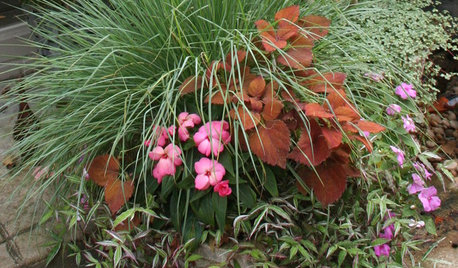Soil mixes for pots
northerner_on
9 years ago
Related Stories

CONTAINER GARDENSContainer Gardening Basics: The Dirt on Soil
Learn the types of potting soil available and the best mixes to help your containers thrive
Full Story
FARM YOUR YARDHow to Get Good Soil for Your Edible Garden
The nutrients in your soil feed the plants that feed you. Here are tips on getting it right — just in time for planting season
Full Story
GARDENING GUIDESHow to Stop Worrying and Start Loving Clay Soil
Clay has many more benefits than you might imagine
Full Story
GARDENING GUIDES10 Solutions for Soggy Soil
If a too-wet garden is raining on your parade, try these water-loving plants and other ideas for handling all of that H2O
Full Story
CONTAINER GARDENSContainer Garden Basics: Mix Textures to Catch the Eye
A mix of textures makes for potted gardens where each plant has a special role to play
Full Story
LANDSCAPE DESIGNHow to Shape a Rain Garden and Create the Right Soil for It
Learn how to grade, lay out and amend the soil in your rain garden to support your plants
Full Story
GARDENING GUIDESGardening Solutions for Heavy Clay Soils
What’s a gardener to do with soil that’s easily compacted and has poor drainage? Find out here
Full Story
GARDENING GUIDESGrow a Beautiful Garden in Alkaline Soil
Got alkaline soil? Learn how to manage it and the many beautiful plants that will thrive in this ‘sweet’ soil
Full Story
GARDENING GUIDESThe Poop Scoop: Enrich Your Soil With Good Old Manure
Get over the ick factor already — this natural super-ingredient for soil has so many benefits, you'll wonder why you ever went chemical
Full Story
GARDENING GUIDESHow to Pick a Mulch — and Why Your Soil Wants It
There's more to topdressing than shredded wood. Learn about mulch types, costs and design considerations here
Full StoryMore Discussions









johns.coastal.patio
Ohiofem 6a/5b Southwest Ohio
Related Professionals
Otsego Landscape Architects & Landscape Designers · Brookside Landscape Contractors · Canby Landscape Contractors · Fuquay-Varina Landscape Contractors · La Verne Landscape Contractors · Lebanon Landscape Contractors · Louisville Landscape Contractors · Chanhassen Solar Energy Systems · Herriman Solar Energy Systems · Reedley Solar Energy Systems · Glendale Heights Window Contractors · Elkridge Window Contractors · Markham Fence Contractors · Tavares Fence Contractors · Whittier Fence Contractorsjohns.coastal.patio
Ohiofem 6a/5b Southwest Ohio
johns.coastal.patio
northerner_onOriginal Author
Ohiofem 6a/5b Southwest Ohio
northerner_onOriginal Author
sharonrossy
johns.coastal.patio
Ohiofem 6a/5b Southwest Ohio
johns.coastal.patio
johns.coastal.patio
johns.coastal.patio
greenman28 NorCal 7b/8a
johns.coastal.patio
seysonn
johns.coastal.patio
greenman28 NorCal 7b/8a
johns.coastal.patio
johns.coastal.patio